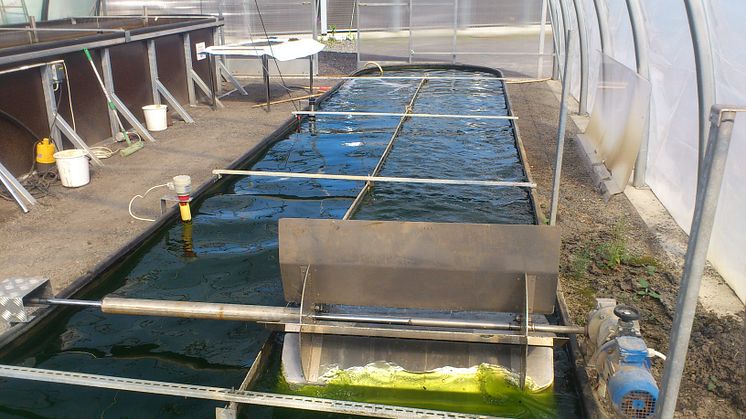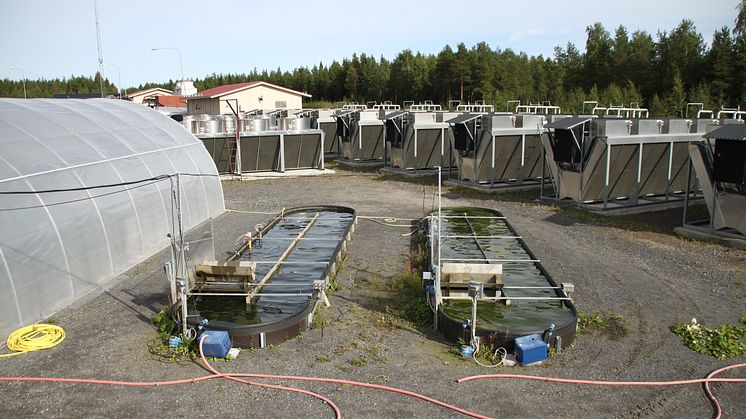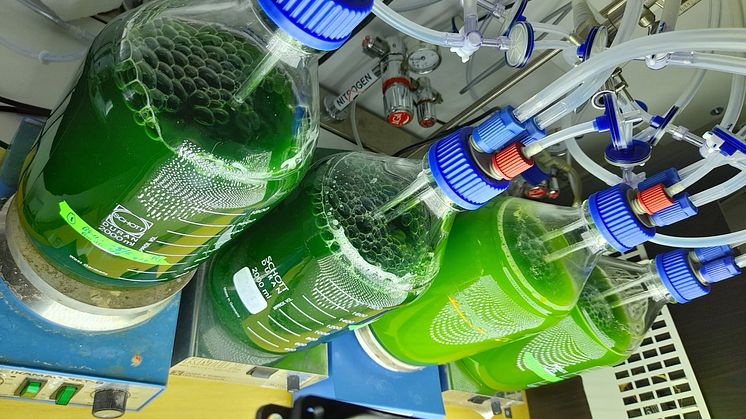
Press release -
Researchers aim to create biodegradable plastic – from algae
The Waste2Plastic project at Umeå University has received SEK 15 million from the Swedish Energy Agency and its industrial partners to produce biodegradable plastics, PHA, using microalgae. The algae are grown in wastewater in Umeå and convert carbon dioxide from flue gases into biomass.
“The biomass will then be fed to bacteria that create plastic for lamps and packaging. We are on our way to a sustainable bioplastics industry,” says Christiane Funk, project manager at the Department of Chemistry.
The development of plastics has been almost exclusively fossil-based, due to both affordable prices and the availability of fossil raw materials. Over the past 50 years, annual global production has increased from 1.5 million tonnes to over 395 million tonnes. Essentially, fossil-based plastics end up in landfills – only about 9 percent of plastic is recycled and 12 percent is incinerated, while the remaining 79 percent will slowly decompose, taking hundreds of years.
“Bio-based plastics, generated from renewable resources, can play an important role in the circular economy to avoid the use of fossil fuels. It also involves new methods for degradation or recycling and less toxic chemicals in the manufacturing stages,” says Professor Christiane Funk.
She continues:
“Biodegradable plastics have been proposed as a substitute to meet future plastic needs, but in 2022, bioplastics accounted for only one percent of the plastic produced in the world. One of the biggest problems for the commercialisation of biodegradable plastics is its high production costs compared to plastics derived from petrochemicals.”
The Waste2Plastic project aims to reduce the carbon footprint by using local strains of Nordic microalgae as raw materials, reducing the consumption of fossil fuels in the production of bioplastics and making the plastics biodegradable.
The algae are grown in industrial and municipal wastewater in Umeå (in collaboration with Vakin and Umeå Energi), where they perform photosynthesis and convert carbon dioxide from flue gases into biomass. The biomass will then be fed to PHA-producing bacteria, which sustainably produce plastic.
The cultivation of microalgae has several positive effects. Carbon dioxide is removed from the flue gases and helps mitigate climate change immediately, microalgae actively remove pollutants in the wastewater recycling process and microalgae biomass is a renewable source that does not require expensive materials, nutrients or arable land.
“Projects like ours will pave the way for the creation of a sustainable bioplastics industry,” says Christiane Funk.
From the environmentally friendly PHA, the project's industrial partners will then design lamps and create packaging materials. With the help of a company in Sundsvall, they will also test the biodegradability of PHA.
She believes that it is very valuable that both Waste2Plastic and Re:Source focus on circularity and sustainability.
“Microalgae are fantastic organisms, which can contribute to a sustainable future. They convert carbon dioxide into biomass, which can then be used in biotechnological processes, they can purify wastewater, they produce most of the oxygen we breathe – and they are beautiful,” says Christiane Funk.
About Waste2Plastic
The project Waste2Plastic – circular economy, recycling of CO2, nitrogen, phosphorus and water for bioplastics in a sustainable society has received over SEK 15 million from, among others, the Swedish Energy Agency’s strategic innovation program RE:Source, which focuses on developing circular and resource-efficient material flows that stay within the planet's boundaries.
The Waste2Plastic consortium consists of researchers from Umeå University (Christiane Funk, project manager, and Leif Jönsson), SLU (Francesco Gentili and Carmen Cristescu), RISE Processum (Lalie Kossatz and Pooja Dixit) and industrial partners.
About PHA
PHA is a biodegradable polymer, which is just as good as fuel-based plastic. Several microorganisms can produce PHAs, but most of them only produce very small amounts. However, some bacteria produce large amounts of PHA. They eat sugar (mostly glucose) and convert it into PHA. Unfortunately, the sugar-rich bacterial feed is very expensive, it makes up 50 percent of the PHA price. Waste2Plastic therefore suggests using microalgae sugar to feed the bacteria. Microalgae perform photosynthesis and in this way, they use sunlight to produce these sugars from carbon dioxide. So they reduce the carbon dioxide content and at the same time produce feed to make PHA.
For more information, please contact:
Christiane Funk, Professor in the Department of Chemistry, Umeå University, Sweden
Phone: +46 90 786 76 33
Email: christiane.funk@umu.se
Topics
Categories
Umeå University
Umeå University is one of Sweden’s largest institutions of higher education with over 37,000 students and 4,300 faculty and staff. The university is home to a wide range of high-quality education programmes and world-class research in a number of fields. Umeå University was also where the revolutionary gene-editing tool CRISPR-Cas9 was discovered that has been awarded the Nobel Prize in Chemistry.
At Umeå University, distances are short. The university's unified campus encourages academic meetings, an exchange of ideas and interdisciplinary co-operation, and promotes a dynamic and open culture in which students and staff rejoice in the success of others.





